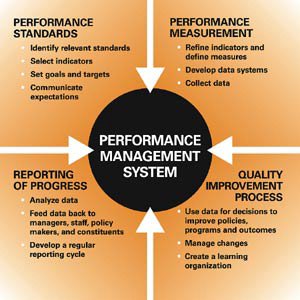Keeping a Public (Site) Healthy
 Browsing the Web can lead to useful insights, even when you don't find what you're looking for. Today I was searching for information about an aspect of Web site performance management. As often happens, Google returned many links to pages where the term performance management was used in contexts having nothing to do with managing Web applications.
Browsing the Web can lead to useful insights, even when you don't find what you're looking for. Today I was searching for information about an aspect of Web site performance management. As often happens, Google returned many links to pages where the term performance management was used in contexts having nothing to do with managing Web applications.On one site, Turning Point, the graphic shown here immediately caught my eye. It was so obviously relevant to my world of application performance management that I studied it for a while before noticing that Turning Point ... is an initiative of The Robert Wood Johnson Foundation and the W.K. Kellogg Foundation. Its mission is to transform and strengthen the public health system in the United States by making it more community-based and collaborative.
This sounds like a worthwhile cause, but in a profession whose technical, management, and political challenges I know little about. Nevertheless, the site's definition of performance management, and its description of the four key components illustrated in the diagram, written for the world of public health, apply equally well to the task of managing your Web site health!
To demonstrate the parallels, the following paragraphs are quoted directly from the Turning Point site, except that I have made some minor edits:
Performance management is the practice of actively using performance data to improveIt seems that whatever your professional focus, you can always find parallels in other fields. Those technical details you've been wrestling with to speed up your Web site may not be a hot topic of conversation at your next dinner party. On the other hand, the process of performance improvement seems to be a concept everyone can relate to.the public'syour site's health. This practice involves strategic use of performance measures and standards to establish performance targets and goals, to prioritize and allocate resources, to inform managers about needed adjustments or changes in policy or program directions to meet goals, to frame reports on the success in meeting performance goals, and to improve the quality ofpublic healthSLM practice.
Performance Management components include:A Performance Management System is the continuous use of all the above practices so that they are integrated into the organization's core operations. Performance management can be carried out at multiple levels, including the
- Performance Standards: establishment of organizational or system performance standards, targets and goals and relevant indicators to improve
public healthSLM practice.- Performance Measures: application and use of performance indicators and measures.
- Reporting of Progress: documentation and reporting of progress in meeting standards and targets and sharing of such information through feedback.
- Quality Improvement: establishment of a program or process to manage change and achieve quality improvement in
public healthSLM policies, programs or infrastructure based on performance standards, measurements and reports.programapplication,organizationWeb site,communityline of business, andstatecorporate levels.
If you chose your words really carefully, people may not even realize you manage a Web site. Just tell them you're a health specialist -- maybe the diagram above will help with your explanation. It worked on me!


0 Comments:
Post a Comment